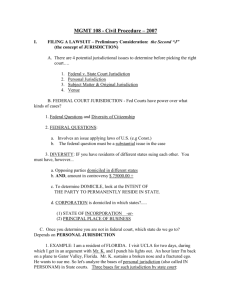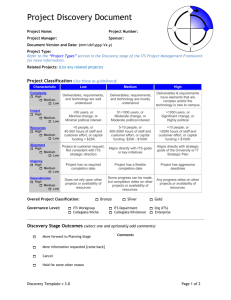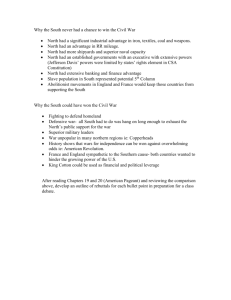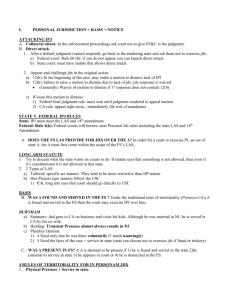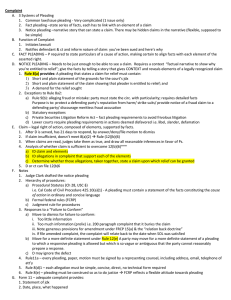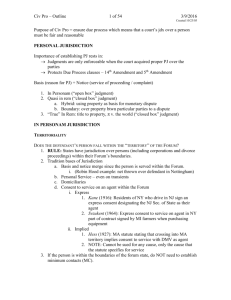JV-CL1
advertisement
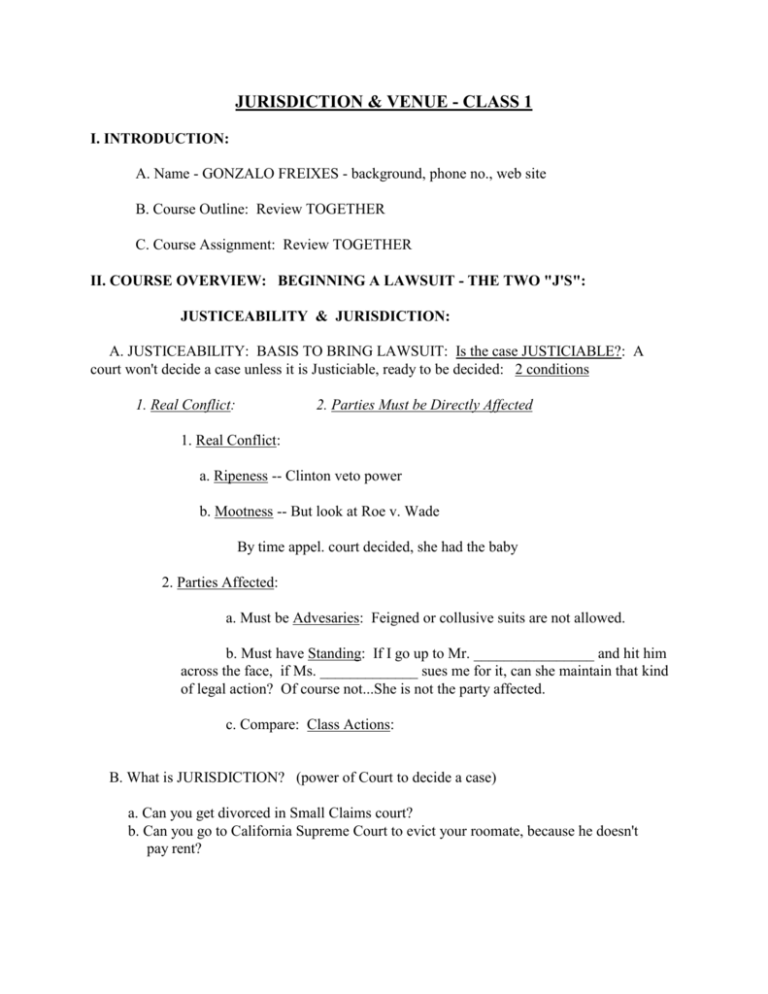
JURISDICTION & VENUE - CLASS 1 I. INTRODUCTION: A. Name - GONZALO FREIXES - background, phone no., web site B. Course Outline: Review TOGETHER C. Course Assignment: Review TOGETHER II. COURSE OVERVIEW: BEGINNING A LAWSUIT - THE TWO "J'S": JUSTICEABILITY & JURISDICTION: A. JUSTICEABILITY: BASIS TO BRING LAWSUIT: Is the case JUSTICIABLE?: A court won't decide a case unless it is Justiciable, ready to be decided: 2 conditions 1. Real Conflict: 2. Parties Must be Directly Affected 1. Real Conflict: a. Ripeness -- Clinton veto power b. Mootness -- But look at Roe v. Wade By time appel. court decided, she had the baby 2. Parties Affected: a. Must be Advesaries: Feigned or collusive suits are not allowed. b. Must have Standing: If I go up to Mr. ________________ and hit him across the face, if Ms. _____________ sues me for it, can she maintain that kind of legal action? Of course not...She is not the party affected. c. Compare: Class Actions: B. What is JURISDICTION? (power of Court to decide a case) a. Can you get divorced in Small Claims court? b. Can you go to California Supreme Court to evict your roomate, because he doesn't pay rent? III. LET’S DO AN OVERVIEW OF OUR FOUR DAYS TOGETHER: A. TODAY: Go over Federal Court Jurisdiction and Subject Matter Jdx. B. CLASSES 2 & 3: Personal Jurisdiction C. LAST CLASS: Venue, Service of Process and Quiz IV. LET’S START WITH FEDERAL COURT JURISDICTION: A. Turn in your materials to... 1. Article III of the U.S. Constitution: Let’s read Section One and Two 2. Section 1332 of 28 USC B. So, FEDERAL COURT JURISIDICTION - Fed Courts have power over what kinds of cases? 1. Federal Questions and Diversity of Citizenship 2. FEDERAL QUESTIONS: a. Involves an issue applying laws of U.S. , the Constitution, Ambassadors or where U.S. is a party (1) What if Mr. ________ sues his roomate in Fed. Court, because, in addition to non-payment of rent, he alleges an invasion of his Constitutional right to privacy by drinking his Diet Pepsi. (a) Would this be a case of exclusive federal jdx. or concurrent jdx? Concurrent. What's the difference. BUT, BUT, BUT.. come on now is this really going to fly -- NO WAY....Why? ---NO - Must be a substantial issue in the case 3. DIVERSITY: IF you have residents of different states suing each other -- Gov. Bush of Texas sues Gov. Davis, each would have advantage if in Texas or Cal. state court. You must have, however... a. Opposing parties domiciled in different states b. AND, amount in controversy > $ 75,000.00 c. To determine DOMICILE, look at the INTENT OF THE PARTY PERMANENTLY RESIDE IN STATE. d. CORPORATION has domiciled in which states?..... (1) STATE OF INCORPORATION (2) PRINCIPAL PLACE OF BUSINESS 4. What happens to Mr. __________ when the Federal Court kicks him out --- what court can he turn to....? D. What about STATE COURTS JDX. 1. We look at two primary aspects: a. SUBJECT MATTER JDX b. PERSONAL JDX. 2. But before we discuss, let’s get some background on LAW & EQUITY V. EQUITY & LAW (REMEDIES): The relief granted to a party who is suing another. A..EXPLAIN TWO COURT SYSTEM IN ENGLAND B. Kinds of Remedies: 1. Money Damages LAW 2. Specific Performance EQUITY 3. Rescission & Restitution EQUITY 4. Declaratory Relief: EQUITY B. Money Damages: Most common when one sues for "Breach of Contract" and torts. 1. Compensatory (general) Damages: Those that arise naturally from the contract = the profits. 2. Consequential (special) Damages: Were foreseeable by the party committing the breach. 3. TORT DAMAGES: Special and General Damages (all money) C. SPECIFIC PERFORMANCE: Ordering a party to perform. 1. Inadequate Legal Remedy: a. This is an equitable remedy. Damages are not available, usually because the item is too valuable or unique b. LAND: Is always considered unique. c. GOODS: Usually this doesn't apply, where it does it's called REPLEVIN -- the recovery or return of specific goods. d. SERVICES: --No one can be ordered to perform services. This would violate the Slavery clause in the 13th amendment to the the constitution. Also, courts have deemed these kinds of orders difficult to supervise. D. RESCISSION & RESTITUTION: Rather than money damages, this remedy prevents the unjust enrichment of the Defendant. May take the form of...aim is to place both parties in the position they had prior to the contract. 1. Rescission: Our voidable contracts. Whenever a Plaintiff seeks restitution it must first cancel or rescind the contract, then it sues.... 2. Restitution: Restores parties to before contract. E.g. -- return of deposits or payments/ goods sold/transferred. F. Other Equitable Remedies: a. Quasi Contract - for value of services or goods delivered. b. Constructive Trust c. Equitable Lien E. REFORMATION: Re-draft portion of the contract to meet parties original intent. Discuss TALMOR case with Reformation of Deed. F. INJUNCTIONS AND RECEIVERSHIPS: 1. Enjoin futher action under contract. a. Also used in many other cases. Explain LAF and apply example of Constructive Trust. 2. Receiver: E.g. -- Assignment of Rents. G. DECLARATORY RELIEF: No actual damage suffered but a dispute arises as to the meaning of clauses in the K. Action brought to have judge declare the meaning of the clause. Typically in insurance actions where person is not cooperating with insurance company or payment of premiums were late, DRA for coverage issues are typically brought. VI. SUBJECT MATTER JDX. A. First Let’s look at CALIFORNIA AND FEDERAL COURT SYSTEM: 1. Federal Courts: District, Appeals, Supreme 2. California Court: Small Claims, Municipal (and Justice), Superior, Appeal and CSC NOTE: Municipal Courts are being abolished and unified with Superior Courts, such that now we have ONE court, but as follows: Superior Court of General Jurisdiction (formerly “Superior Court”) Superior Court of Limited Jurisdiction (formerly “Municipal Cour”) Small Claims still exists (within the Superior Court framework) B. California Constitution: See Article VI C. Superior Court of California (“of General Jdx.”): 1. Has “General Jdx” over all cases with some exceptions... a. Federal Court cases b. Municipal & Justice Court (includes Small Claims) c. Administrative Tribunals (e.g. WCAB, Labor Commissioner, etc.) 2. Money Damages: Let’s look at breakdown... a. Small Claims: 0 - $ 5000 b. Municipal & Justice: $ 5000 to 25,000 c. Superior Court: $ 25,000 and above 3. Criminal: Misdemeanor and Felonies (explain) 4. Equity Relief Sought: Superior Court has Subject Matter Jdx over… Injunctions, Declaratory Relief, Title to Real Property 5. Subject in Exclusive SC domain... a. Family Law b. Probate c. Guardianships and conservatorships d. Eminent Domain e. Corporate Dissolution f. UM Arbitration 6. Concurrent Jdx: Where two or more suits are filed... a. First Superior Court has jdx to hear... b. Second one must ABATE c. This only becomes an issue IF raised by one of parties... (1) Demurrer (“another action pending”) (2) Affirmative Defense in Answer (3) Motion to Dismiss or Transfer D. MUNICIPAL & JUSTICE COURTS (Now called “Superior Courts of Limited Jurisdiction” in most counties – we will refer to them as “Municipal” Courts for ease of discussion): 1. What’s the difference? a. Municipal Court (40,000 residents or more) 2. Large Counties: Los Angeles has numerous judicial districts: a. Los Angeles: Many branches - Central, Van Nuys, San Pedro, San Fernando, West LA, etc. b. Numerous districts in surrounding areas: Burbank, Newhall, Lancaster, Glendale, Pasadena, Huntington Park, West Covina, Compton, Inglewood, South Bay, Long Beach, etc. 3. Actions at Law: JDX where amount in controversy or value of property is $ 25,000 or less.: a. Includes Unlawful Detainer (evictions) where damages 25K or less 4. Equity: a. No general Equitable Power b. Only incidental to case filed for under 25K. c. In NO EVENT can they grant... (1) Permanent Injunctions (2) Determine title to Real Property (3) Family Law matters (4) Declaratory Relief (a) Except for 3rd party Indemnity claims (EXPLAIN) d. They DO have equitable power over the following IF amount in controversy is $ 25K or less: (EXPLAIN WHAT EACH IS) (1) Rescission of contracts (2) Reformation (3) Dissolution of partnership (NOT a corporation) (4) Title to PERSONAL property (5) Liens on personal property (6) Mechanic’s Liens or real property E. DETERMINING THE AMOUNT IN CONTROVERSY: 1. Based on PRAYER demand (not on what evidence will later show) a. Even if verdict or judgment turns out to be less than 25K, Superior Court still has jdx. to award. 2. Stating “in excess of minimum jdx’l limits of SC “or “in excess of 25K” is enough to grant SC jdx. 3. Eviction: Look at whether RENT is more or less than 25K 4. Personal Injury or Tort Claims: 1. CANNOT state amount in controversy...(anyone know why) 2. Movie Stars and others: 5. So what’s to Stop Plaintiff from LYING to get case into Superior Court? a. No court costs awarded if final verdict/judgement less than 25K b. Procedures in SC more complicated, longer: Fast Track, years to get to trial, mandatory arbitration, etc. c. SC has power to transfer case to SC. 6. What’s NOT included in estimation of amount in controversy... a. Attorneys Fees (explain when recovered) b. Court Costs c. Interests or civil penalties 7. Plaintiff can WAIVE more than 25K to ensure proper MC jdx. 8, What if Plaintiff sues... a. ONE DEFT: If aggregate of all claims filed in different causes of action exceed $ 25K must go to SC. b. SEVERAL DEFTS: Plaintiff can recover $ 25K or less against each one, even if total award would be more than $ 25K. 9. Cross Complaints: a. Can kick a case “upstairs” to SC if over $ 25K (good tactic as Deft) b. Can force a case “downstairs” if Complaint for more than 25K but Cross Complaints isn’t and complaint gets dismissed for some reason. 10. What to do if you sue for $ 25K or less and then through discovery you realiaze that damages are more? a. Can file an amendment or motion to transfer to SC. F. CHALLENGING DEFECTS IN SUBJECT MATTER JDX. 1. Fatal to a case if it does not exist. Parties cannot “stipulate” that a court hear a case if it lacks subject matter jdx. 2.Procedures for Challenging: (EXPLAIN WHAT EACH OF THESE ARE) a. Demurrer b. Motion to Strike c. Motion for Judgment on the Pleadings d. Summary Judgment e. Motion to Transfer f. Affirmative Defense in the Answer 3. Can be raised AT ANY TIME in the case, until Judgment granted. VII. FEDERAL COURT vs. STATE COURT A. EXCLUSIVE: Some cases can ONLY be tried in Federal Court…. 1. 2. 3. 4. 5. 6. Patents Admiralty/Maritime Bankruptcy Antitrust SEC Federal Labor Laws & ERISA B. CONCURRENT : Unless specifically prohibited from State Courts, a federal claim can be tried in State Court. These are cases of Concurrent Jdx. 1. Federal Question: But, the Defendant can REMOVE the case to Federal Court if they want to. 2. Diversity Cases: Can always be filed in State court…..BUT 3. Removal: If either a FED. QUESTION or DIVERSITY case filed in State Court, the Defendant may cause its REMOVAL to Federal court…. a. EXCEPTION: If any ONE Defendant also resides in same state as Plff. b. Procedure: Simply file a NOTICE OF REMOVAL C. Which law do we apply: Whether case stays in State Court or goes to Federal Court… 1. Federal Question: Decided by federal law 2. Diversity: Substantive State Law and Procedural Federal Law (if in Fed Court) D. Why FEDERAL COURT v. STATE COURT: 1. 2. 3. 4. 5. Delay to get to trial Intimidation Factor Fast Track type rules Hometowning Jury Verdicts: 6 in federal & unanimous civil verdicts (different in California) VIII. LET’S GO THROUGH ASSIGNMENT….. IX. LET TRY BRIEFING CASE TOGETHER - Group Project (Tectonics Case) A. Elements of Traditional Brief: 1. Follow this format PARTIES FACTS PROCEDURE ISSUE DECISION REASONING 2. PARTIES: Generally you have two parties, what are the two parties in all lawsuits called? a. PLAINTIFF: b. DEFENDANT: c. Sometimes it get's tricky.... (1) Appellant, Respondent, Cross-Complainant Cross-Defendant d. FACTS OF CASE: You all know the facts. -- Plaintiff: -- Defendants: -- Appellant: -- Respondents 3. FACTS OF THE CASE: Just describe the basic important facts of the case. Don't overdo it...rather too short than too long. I have never heard of a brief that's too short. Clearly more than one-half of student briefs are too long, way too long. 4. PROCEDURE: How the case proceeded in the lower court and how it got to the court that is deciding it now... 5. ISSUE: What's the legal point of the case, which determines its outcome. a. Was the jury instruction given by judge erroneous? b. Were the legal elements established? 6. DECISION: The appellate court's decision… 1. Affirm 2. Reverse (& Remand?) 3. Modify 7. REASONING: Why the court decided the case the way they did. What rules of law did they apply, what standards/concepts were pivotal. B. Let's do the INDUSTRIAL TECTONICS Case in groups…….
